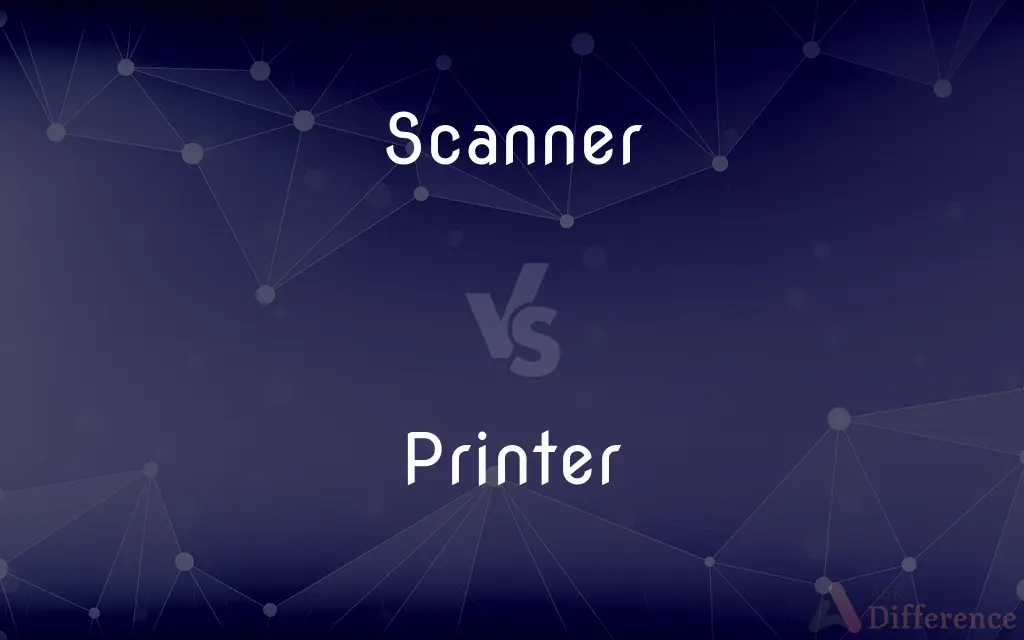Scanner vs. Printer — What's the Difference?
By Urooj Arif & Maham Liaqat — Updated on March 15, 2024
Scanners digitize physical documents into electronic formats, while printers do the opposite by creating physical copies of digital documents.

Difference Between Scanner and Printer
Table of Contents
ADVERTISEMENT
Key Differences
Scanners are devices designed to capture images from photographic prints, posters, magazine pages, and similar sources for computer editing and display. Printers, on the other hand, take digital documents and produce physical copies, effectively making information portable and accessible without the need for electronic devices.
While scanners work by illuminating the document to digitize it, capturing its details with an optical sensor, printers operate by applying ink or toner onto paper to recreate the digital document's content. This fundamental difference in functionality highlights their complementary roles in digital and physical document handling.
Scanners can vary widely in their capabilities, from basic document scanning to high-resolution imaging for photographs and artwork. Printers also vary, from simple black-and-white laser printers to complex color inkjets that can print on various types of media, indicating the diverse applications of each tool.
One of the main uses of scanners is to create digital archives of physical documents, allowing for easy storage, sharing, and editing. Printers, whereas, are primarily used for producing hard copies of documents for distribution, display, or filing, underscoring the tangible aspect of information dissemination.
Both scanners and printers have evolved to include multifunction devices that combine scanning, printing, and sometimes faxing and copying capabilities, demonstrating the integration of digital and physical document processing in contemporary workflows.
ADVERTISEMENT
Comparison Chart
Primary Function
Digitizes physical documents
Produces physical copies of digital documents
Process
Captures image with optical sensor
Applies ink/toner onto paper
Main Use
Creating digital archives
Producing hard copies for use
Varieties
Document scanners, photo scanners, etc.
Inkjet, laser, dye-sublimation printers, etc.
Output
Digital file (e.g., PDF, JPEG)
Physical document or image
Compare with Definitions
Scanner
Offers varying resolutions for different needs.
The high-resolution scanner was perfect for archiving detailed documents.
Printer
Can print on different types of paper and materials.
The printer handled both glossy photo paper and standard sheets effortlessly.
Scanner
Facilitates easy sharing and editing of documents.
Scanning the contract allowed for quick digital edits and email distribution.
Printer
Enables the distribution of tangible documents.
Printing flyers for the event allowed for wide physical distribution.
Scanner
Essential for creating digital archives of physical documents.
The office scanner helped digitize decades of paper records.
Printer
Creates physical versions of digital documents.
The printer produced a hard copy of the report for the meeting.
Scanner
Uses optical sensors to capture images.
The scanner precisely captured the colors of the original artwork.
Printer
Applies ink or toner to paper.
The color printer used various inks to reproduce the photo vividly.
Scanner
Converts physical documents into digital formats.
The scanner turned our family photos into digital memories.
Printer
Plays a key role in visual communication.
The printer was essential for producing high-quality marketing materials.
Scanner
One that scans
A scanner of newspapers.
Printer
A person whose job or business is commercial printing.
Scanner
A receiver that continuously broadcasts signals it detects from specified radio frequencies
Heard about the robbery over the police scanner.
Printer
One that prints, especially one whose occupation is printing.
Scanner
An optical scanner.
Printer
A device that prints text or graphics on paper.
Scanner
A device, such as a CT scanner or PET scanner, for observing internal organs, tissues, and other parts of the body.
Printer
A 3D printer.
Scanner
A device which scans documents in order to convert them to a digital medium.
He put the picture in the scanner, then e-mailed a copy of it to his family.
Printer
One who makes prints.
Scanner
A radio receiver which iterates through a sequence of frequencies to detect signal.
Printer
The operator of a printing press or the owner of a printing business; (metonymy) any printing business.
Scanner
A device which uses radiation (ultrasound, X-ray, etc.) to generate images of tissue or surfaces for diagnostic purposes.
Printer
A device, usually attached to a computer, used to print text or images onto paper; an analogous device capable of producing three-dimensional objects.
Scanner
A device which uses optics to detect printed data (such as a barcode).
Printer
One who prints; especially, one who prints books, newspapers, engravings, etc., a compositor; a typesetter; a pressman.
Scanner
One who scans.
Printer
Someone whose occupation is printing
Scanner
Someone who scans verse to determine the number and prosodic value of the syllables
Printer
(computer science) an output device that prints the results of data processing
Scanner
An electronic device that generates a digital representation of an image for data input to a computer
Printer
A machine that prints
Scanner
A radar dish that rotates or oscillates in order to scan a broad area
Scanner
A radio receiver that that moves automatically across some selected range of frequencies looking for for some signal or condition;
They used scanners to monitor police radio channels
Common Curiosities
How does a scanner work?
It illuminates the document and uses an optical sensor to capture its image, converting it into a digital format.
What types of documents can you print with a printer?
Anything from text documents, photographs, posters, to custom materials depending on the printer's capabilities.
What is the primary function of a scanner compared to a printer?
A scanner digitizes physical documents, while a printer produces physical copies of digital documents.
How have scanners and printers evolved over time?
They've become more integrated and versatile, with improved resolution, speed, and additional functions like wireless connectivity.
What are some common file formats for scanner outputs?
Common formats include PDF for documents and JPEG, TIFF for images.
What makes printers essential in an office setting?
They provide the ability to distribute physical documents, essential for meetings, presentations, and official paperwork.
How do scanners and printers contribute to a paperless office?
Scanners facilitate digitization and electronic storage, while printers are used less frequently as digital document sharing becomes more prevalent.
Can scanners and printers be used together?
Yes, they often complement each other in workflows, with scanners digitizing documents for editing and printers producing hard copies of digital files.
What are multifunction printers (MFPs)?
Devices that combine the functions of scanners, printers, and sometimes fax and copy machines.
How do resolution capabilities differ between scanners and printers?
Scanners focus on capturing details accurately, requiring high resolution for clarity, while printers require sufficient resolution to reproduce details in print form.
How do printing technologies vary among printers?
Technologies vary from inkjet for versatile color printing, laser for fast, high-volume monochrome prints, to dye-sublimation for high-quality photo prints.
What factors should be considered when choosing a scanner or printer?
Consider resolution, speed, function (single or multifunction), media handling capabilities, and connectivity options.
What is a key advantage of using a scanner?
It allows for the digital archiving and easy sharing of physical documents.
Can a printer produce the same quality as the original digital document?
High-quality printers can closely match the original, but factors like printer type, ink quality, and paper affect the final output.
What are the environmental considerations for using printers and scanners?
Considerations include energy consumption, ink usage and disposal, and paper sourcing and recycling.
Share Your Discovery

Previous Comparison
Those vs. They
Next Comparison
Bully vs. MolestAuthor Spotlight
Written by
Urooj ArifUrooj is a skilled content writer at Ask Difference, known for her exceptional ability to simplify complex topics into engaging and informative content. With a passion for research and a flair for clear, concise writing, she consistently delivers articles that resonate with our diverse audience.
Co-written by
Maham Liaqat














































